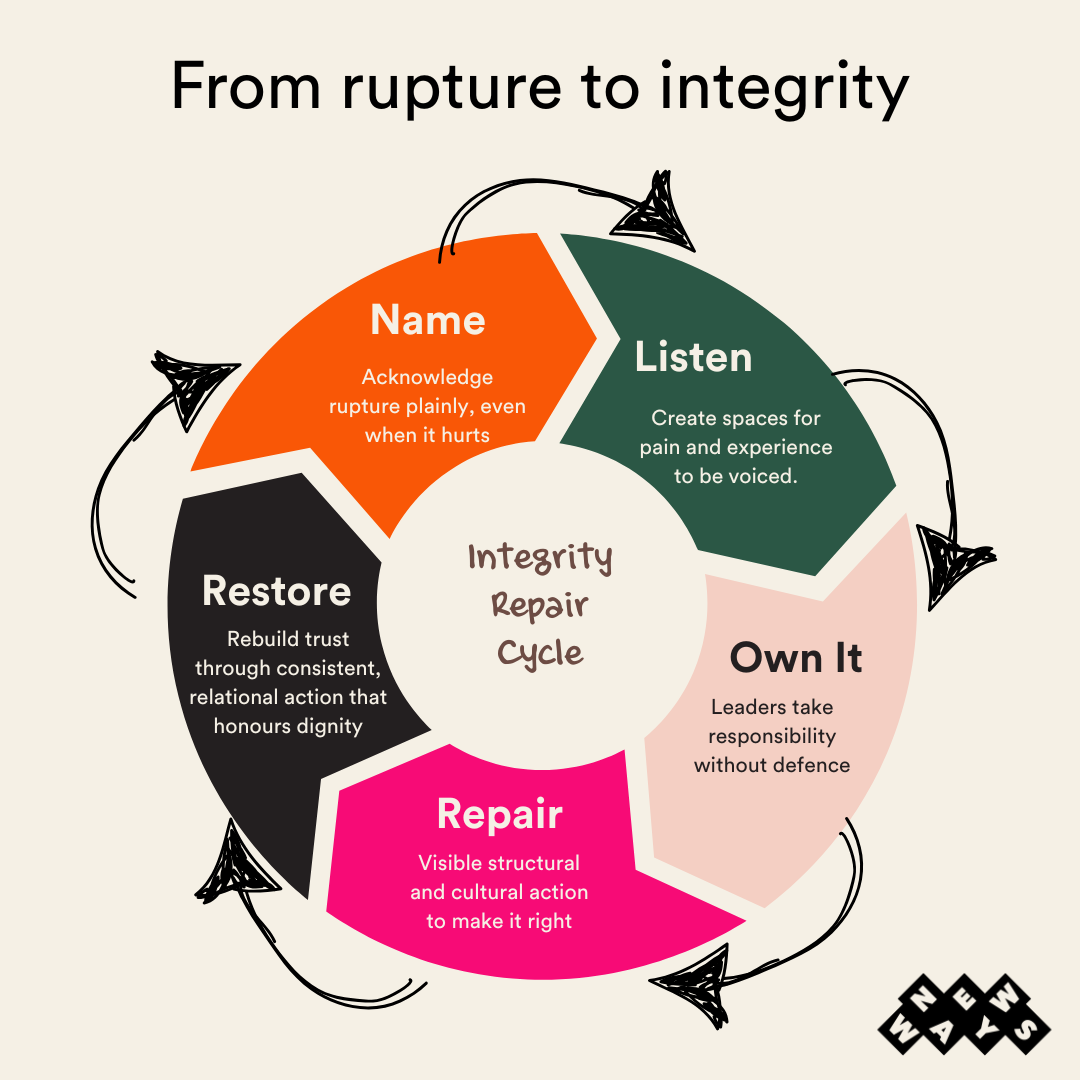When Trust is Broken: Integrity Ruptures and the Work of Repair
Rupture Diagnostics and Find Your Way Back through Healing
Rupture is inevitable. No organisation, leader, or movement can live perfectly in alignment with its values all the time. Most organisations will face moments when the integrity of their mission, leaders, or culture is shaken. Sometimes, it happens in public, perhaps an organisation or a leader being called out for hypocrisy, or being exposed for saying one thing and doing another. Other times it happens inside teams, where internal practices, decisions and choices reveal misalignment with values, raise questions about the mission or undermine core principles.
In my experience, integrity challenges cut deepest when belief in the mission is high. In our work alongside third sector and positive impact businesses, people join not just for a job but because the cause is closely connected to personal values and identity. They often see the organisation as a place to practice these convictions.
They chose to be here because of the integrity this organisation brings to how they achieve their mission - perhaps working on root causes and not being stuck on the symptoms, perhaps because of the comprehensive way they’ve integrated race equity into their organisation and culture, perhaps because of the powerful reputation of a founder or brand ambassador and their impact, or perhaps because of the boldness in which they are disrupting and going about change.
When integrity ruptures occur in that context - when promises fracture, or actions contradict the stated values - the impact is visceral. It isn’t just professional disappointment. It feels existential, as if a part of their own integrity has been betrayed.
The Faces of Organisational Integrity Ruptures
It wasn’t until I sat down to write this article that I realised just how many projects we’ve worked on have involved integrity ruptures. We’ve often been called in once an ‘us’ and ‘them’ divide has started, and the leadership team needs support to repair and heal. This is a challenging time to come in as a consultant. It needs a great deal of care to ensure that you are seen from the outset as someone with real integrity, someone to be trusted - but that’s probably a whole other piece of writing on its own.
Here are some of the themes that have stood out to us about integrity ruptures and the contexts in which they arise.
Bold Feminism, Practices of Oppression
When an organisation’s external brand or voice is strongly rooted in feminist principles - intersectional feminist values, speaking truth to power, and focusing on solving root causes - but in a critical moment, leadership undermines this with racism, misogyny or patriarchal behaviours of dominance, control or colonial thinking, it can be extremely challenging. I’ve seen this rupture occur a few times in different contexts, and it cuts to the core because the very ethos they project is undermined from within.
Equity Outside, Inequity Inside
When an organisation’s mission is to support Black communities to overcome economic hardship, yet inside the organisation Black staff feel they are underpaid and undervalued the integrity rupture feels deeply personal. It’s confronting when externally there’s been strong messaging about anti-racist practice, and that was part of what drew you in, but internally, teams are under-equipped to handle occurrences of racism, however it manifests. This gap between external promise and internal practice makes the harm especially hard to navigate, because it can feel like intentional gaslighting when usually it’s a mix of unintentional carelessness - that comes from inaction, missed opportunity and lack of attention.
Silenced/ing on Palestine
When teams want to speak or act on global injustices, such as Palestine, and leaders are seen to choose silence or actively silence others, relationships can start to break down. In our experience, it becomes an integrity rupture when there was a belief - because of organisational values, anti-oppression ethos, leadership reputation - that we would behave differently.
For some, the rupture is quiet but devastating: a total loss of respect for their organisation’s credibility because it stayed silent, leading to growing disconnection. For others, the rupture comes after they try to instigate conversations or explore organisational action, only to be shut down by leadership. Either way, the effect is the same: painful divides open up, and the integrity of the organisation as a place of moral courage is profoundly undermined.
Global Brand, Colonial Practice
When a global organisation is celebrated for leadership on social change - whether in environmentalism, women’s empowerment, or international development - yet its benefits, policies, and priorities are designed primarily for Northern Europe, with European values as the assumed norm, we have the conditions for integrity ruptures.
As calls for decolonisation grow louder, this systemic integrity gap is becoming more visible and more impactful. Organisations that speak with global authority but fail to reckon with colonial legacies are steadily losing credibility. When what is preached globally is contradicted internally, trust in the mission and its leaders begins to unravel.
Poor Response to Complaints
When racism complaints are mishandled or minimised until they spill into public view, this has alot of potential to create ruptures The harm lies not only in the original incident but in the response. In fact, it’s the stories of how it was handled that stay strongest in organisational memory. We’ve had more than one client who has a memory of ‘the meeting’ and everyone knows the deep context and impact of this shorthand, whether they were in that meeting or not. The rupture is a result of the organisation’s failure to protect staff and stand by its values, revealing that its integrity falters when courage is most required.
Organisational Trauma and Wounds
If not handled quickly and effectively, ruptures become organisational wounds. I love the work of Patricia Vivian and Shana Hormann, who wrote a book about their observations on this topic - they describe organisational trauma as a collective wounding that overwhelms an organisation’s protective capacity, whether from a single event or repeated harm.
When wounds form, organisations can close in on themselves, develop amnesia about their stated values, or fracture into us versus them. Integrity collapses into camps, and what once held people together is pulled apart.
Rupture and Repair
Deb Dana, working from a nervous system perspective, names rupture as the breaking of trust or connection, an event that disrupts a sense of safety. Repair is the act of restoring that connection through acknowledgement, accountability, and visible change.
Rupture is a felt experience, we feel it in our body. And following that, we lose a sense of safety we once had, and our neuroception, the nervous system’s radar for safety and danger, becomes hyper-alert. People begin scanning for risk, questioning every signal, bracing for harm. In organisational life this looks like mistrust of leadership statements, suspicion of new initiatives, and hypersensitivity to perceived slights or exclusions.
This is why repair is so hard. Once safety has been challenged and values betrayed, every attempt at rebuilding trust is filtered through a system on high alert. Leaders often mistake this for resistance or cynicism, when in fact it is the body’s survival response to betrayal.
Why the Pain Runs Deep
The rupture of organisational integrity destabilises more than trust in leaders. It compromises people’s values, the very reason they joined. When it falters, it feels existential: If the organisation I trusted to live these values cannot uphold them, what does that mean for me?
The Way Back: Stages of Repair
Drawing from both organisational practice and trauma-informed work, I see five stages leaders can lean into when trust has been broken:
This cycle is not linear. Organisations may circle back through these stages more than once. But each loop, if entered with courage, strengthens the collective fabric rather than fraying it further.
Practice Prompt: Integrity Check-In
I’m curious to hear where you see integrity ruptures in your work, and what you’ve seen that helps move towards repair and healing.
I’ve put together a set of questions that might be helpful when considering how to move through the integrity repair cycle. I’d love to know how they support you.
Ho
1. Naming
What truth about a rupture or wound am I avoiding naming out loud?
2. Listening
Who needs to be heard in this moment, without me rushing to fix or defend?
3. Owning
Where is my responsibility in this rupture, and what do I need to own clearly?
4. Repairing
What visible action or shift would show we are serious about making this right?
5. Restoring Relationship
How can we move at the speed of trust to ensure lasting repair?



